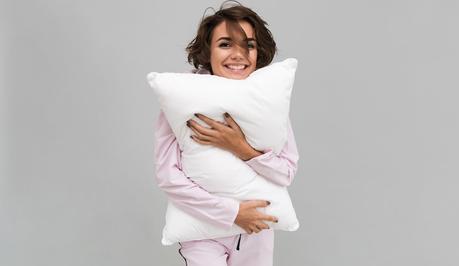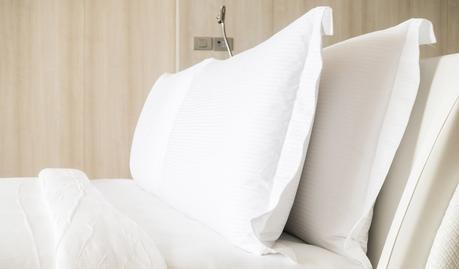Many people believe that feather and down are different words for the same thing. That is not the case! Feathers are coarser than down - why? It's because, unlike feathers, down has no quills. It comes from the soft, fluffy feathers on the underbelly and chest of birds. It is mainly ducks and geese that are used for pillow feathers and down, though swan down is also used.
The quilled feathers are larger and come from the wings and the backs of the birds. The down is to keep them warm, while the feathers are designed to allow flight. It is important to know the difference between down and feather pillows so you can make the correct choice to suit your personal needs. So what's best for you? A down or feather pillow.
As stated, the down and feathers used in pillows come predominantly from geese and ducks. We shall compare the two types of filling later, but which of these makes the better pillow? Down or feathers; ducks or geese? There may be no definitive answer, so let's first have a look at the advantages of a feather vs. down pillow and you can decide which would suit you the best, a down or feather pillow.
The Difference Between Down and Feather Pillows

On the face of it, a down pillow would seem the most comfortable to lie on while a feather pillow would give more support. However, there is more to it than that! Let's have a look at some of the more important properties of down and feathers.
Fill Power and Fill Weight
These two properties are often misunderstood, so let's check out what they really mean and how the structure of down and feathers can be used to your advantage.
Fill power: This is the volume that one ounce of down takes up. Down comes in a clustered structure. The larger the size of the down clusters, the greater the fill power. The best material is the down taken in colder climates and from older birds. The structure of such down is softer than clusters taken from younger birds in warmer climates. The best pillows use down with a fill power of 650 to 850, while the cheaper pillows will likely contain lower fill power down. The fluffiest and largest down clusters come from larger, older birds. For that reason, goose down is better than duck down!
Fill Weight: As would be expected, the more down clusters that can be packed into the pillow, the firmer that pillow will be. So the highest fill weight generally provides a firmer pillow, and lower fill weights lead to softer pillows. Due to the cost of the different types of down, the larger the clusters and the greater the fill weight, the more expensive the pillow.
Which is Better: Feather or Down Pillows?
The firmness or softness of your pillow will depend on the size of the down clusters used to fill it and on the fill weight. Here are the more important properties of a pillow and whether feathers or down meet them best.
Loft: The loft of a pillow is how thick and plump it is. The best pillows tend to maintain their loft through the night and not flatten down. Down pillows offer more loft than feather pillows and are generally plusher. The main reason for this is the three-dimension shape of down clusters compared with the flatness of feathers.
Comfort: Feather pillows tend to be flatter than the plumpness of down pillows. Feathers have quills that can poke through the pillow and scratch your skin. They are not as comfortable as down pillows but are less expensive.
Pillow Life: Pillows wear out, and have to be replaced, so which of the two (down or feather) lasts the longest? You may think that is the feather pillow because they are coarser than down and hence should last longer. However, it is actually down which lasts longer because the spherical shape of down clusters, especially goose down, enables the down clusters to spring back to their original shape while flattened feathers tend to stay flat.
Do you sleep hot? Feather pillows tend to be cooler to sleep on than those filled with down. Down clusters trap heat and they take much longer to cool than feathers do. If you wake up in the night feeling your face and neck hot, then perhaps you should change to a feather pillow - or a mixture of feathers and down.
Cost: Down pillows are significantly more expensive to buy than feather pillows - 2-3 times the price! If the price is irrelevant to you then you should choose goose down. If you are on a tight budget and don't need the luxury of down, then go for feather pillows.
Mixed feathers and down: In deciding whether you would prefer a feather pillow or a down pillow, keep in mind that most are mixed feathers and down. The proportion of down can vary from about 5% upwards. It is added to a feather pillow to increase its loft and softness, and help prevent it from flattening too much. After use, down can return to its original fluffy shape while feathers tend to stay flat. The more down in a feather pillow, the higher the price because goose and swan down are more expensive than goose or duck feathers.
Which Pillow Would Best for You?

They type of pillow you use is important. For example, which is the better for side sleepers or stomach sleepers? What if you suffer from asthma? Does it matter? In fact, it does, and if you take your sleeping position into consideration when choosing your pillow then your choice of down or feather pillow should be easy to make. Here are our recommendations for the three sleeping positions: back, stomach, and side:
Back Sleepers: Down compresses well and can easily be reshaped. It offers comfortable and sufficient support while sleeping on your back.
Stomach Sleepers: Stomach sleepers will usually find that a down pillow is best for them because it provides excellent comfort and good support, while also compressing well without losing its shape.
Side Sleepers: If you normally sleep on your side then you will need something plusher and more supportive than is needed by stomach or back sleepers. A blend of down and feathers meets your needs although if you want to save a little cash, an all-feather pillow would also give you a comfortable night's sleep. However, make sure that the fill power is high enough. It should be at least 650 and you don't want a pillow that is too high or too low to begin with. Too high a pillow can lead to neck and spine pain due to your neck and spine being misaligned. Too low a pillow can put too much pressure on your shoulder.
Cleaning Feather and Down Pillows
You should keep feather pillows dry. If they get wet, they can emit an odor if left to dry naturally. In saying that, you can machine wash down and feather pillows on a low heat setting. You can then tumble dry them on a low setting, checking every 15-20 minutes and plumping them up as they dry. However, as stated earlier, if they get wet through a spillage of water (e.g., soda, tea/coffee, or any other drink) then make sure they are dried thoroughly before use. You may have to machine wash a pillow if the spillage is extensive and dry it as above. It may be safer for you to have feather and down pillows professionally dry-cleaned.
Frequently Asked Questions
Here are some questions we have frequently been asked about and the difference between down and feather pillows. Should they choose a down or feather pillow and how long do feather pillows last?.

Feather Pillows Vs. Down Pillows: Conclusion
In the feather pillows vs. down pillows debate, much depends on whether you primarily want comfort or support. Down gives you comfort and feathers provide support, and there are pillows filled with a mixture of both if you prefer. The difference between down and feathers is the soft clusters formed by down. Another difference is the price
You can find a comparison of our best six down pillows here, and of our best five feather pillows here. You will note that of the five, four are a mix of goose and feather down, only one being 100% goose feathers. Of the six down pillows, all but one also contains goose feathers. Feathers add to the longevity of the pillow and improve the cooling power of the pillows.

